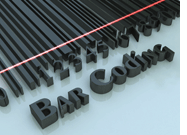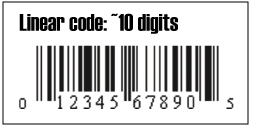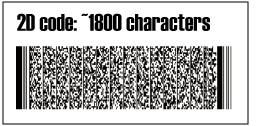
The pinstriped lines of barcodes past are going the way of the vinyl LP – at least for many applications. Instead of the staid black-and-white bars, you are likely to find a chaotic looking area of scrambled dots. Thanks to the advances in tracking technology, barcodes have come a long way since their introduction in the early 1950s.
The barcode’s evolution is linked with society’s need for increased security and data storage. Hot on the heels of first-generation linear barcodes, the new breed of two-dimensional (2D) barcodes are less likely to fail and are capable of holding much more information than their predecessors.
The battle in the supply chain …
But the barcode, in general, is facing competition for a more ‘advanced’ technology, RFID (radio frequency identification technology). RFID is getting the most press, because it holds the promise of improved operations via the capturing of information throughout the supply chain via wireless “readers” and tags that don’t require line-of-site scanning.
The problem with RFID remains the relatively higher cost of readers and tags. Upgraded barcode technology, on the surface, seems more financially feasible. It’s cheaper to upgrade to 2D than to RFID, and you get a system more effective, sophisticated and secure than its predecessor.
 2D bar codes carry more data in the same amount of space to meet the increasing demand on the part of suppliers, distributors and retailers about products and product movement along the supply chain, says Jonathan Palmer, a professor at William and Mary College in Virginia, who studies the technology. Because they are cheaper to transition to from 1D than RFID, many companies in the retail, supply chain, shipping and tracking industries are taking them seriously.
2D bar codes carry more data in the same amount of space to meet the increasing demand on the part of suppliers, distributors and retailers about products and product movement along the supply chain, says Jonathan Palmer, a professor at William and Mary College in Virginia, who studies the technology. Because they are cheaper to transition to from 1D than RFID, many companies in the retail, supply chain, shipping and tracking industries are taking them seriously.
 “2D technology gives you 80% of the bang for 20% of the buck,” says Alan Melling, senior director of EPC Solutions for Holtsville, New York-based Symbol Technologies, who has 30 years’ experience working with barcode technology.
“2D technology gives you 80% of the bang for 20% of the buck,” says Alan Melling, senior director of EPC Solutions for Holtsville, New York-based Symbol Technologies, who has 30 years’ experience working with barcode technology.
Trading pinstripes for precision isn’t free, which is why companies are wracking their brains, wondering if they should even bother with 2D. As several executives suggested, it’s at least worth a cursory investigation.
2D: “It’s not your father’s barcode”
The term “2D” doesn’t refer to a single, specific barcode symbology. Rather, it refers to a new breed of technology. Several dozen companies make their version of 2D barcodes, many of which are public domain. The most common standardized symbology is PDF417, developed by Symbol Technologies in 1990. PDF417 packs up to 1,800 characters in a small space, says a Symbol spokesman. Other sources warn, however, that while the specification suggests this number is possible, it is difficult to obtain this level of compaction – thus a number around 1,000 characters may be more realistic.
2D barcodes use a variety of methods to fit more data into that same amount of space, adds Mr. Palmer. They utilize the horizontal and vertical spaces (as opposed to the horizontal-only reads of traditional of bar codes) through smaller matrix designs to allow more data to be imprinted on the 2D barcode.
“The additional data also allows room for better error checking,” Mr. Palmer adds, “so the reading accuracy (is) enhanced.”
2D in the real world
There are many applications for which 2D barcodes have an advantage over simple linear codes. At shipping giant UPS, the need for a more sophisticated barcode grew as the shipping company expanded, says Donna Barrett, technology public relations manager for the Atlanta-based company.
About a decade ago, UPS grew so big that it needed a bigger code that could hold more and different information than the traditional barcode, Ms. Barrett says. Packages needed to have at least one omni-directional code as they moved through the package sorting facilities. So UPS introduced the “MaxiCode” – a second-generation code. The new barcodes hold up to 248 characters, and are used in conjunction with two linear barcodes on all packages that go through the supply chain. While scanning a single linear code is cheaper, “when you’re dealing with 14.1 million packages a day, redundancy is a good thing,” Ms. Barrett says.
If you’re not UPS, and readability of millions of supplies isn’t an issue, your institution may want to reconsider whether the upgrade to 2D is necessary, says Jake Jacobs, senior vice president of sales at Arthur Blank & Co., whose clients include major gift-card manufacturers.
Improvements in 1D barcodes have also occurred
Over the last two decades, 1D barcodes have enjoyed tremendous improvements, Mr. Jacobs says. Most 1D or traditional barcodes look nothing like their vintage relatives – they use much more durable, high-resolution ink and can hold a greater amount of data, adds Keith Goldstein, also of Arthur Blank & Co.
“The challenge that we all have with 2D barcode acceptance is the integration,” says Mr. Jacobs. “It’s a huge, multi-million dollar overhaul, to change readers to accept 2D barcodes and the retailers want to know if the ROI is worth it,” or whether the cost clearly outweighs the benefits.
Perhaps the biggest benefit is the fact that sticking to the tried and true doesn’t require a huge financial overhaul – you can still use existing equipment. “Because barcodes came out many years ago, there’s a very strong infrastructure that will read 1D, but not 2D,” Mr. Goldstein says. Thus, there isn’t a lot of demand for 2D barcodes among ABCO’s clients.
2D versus RFID
Is it worth it to invest in 2D when the future’s slated for RFID? That’s one of the biggest questions from those exploring new technologies in a world where keeping tabs on goods is becoming increasingly complex. The answer, it seems, depends on the needs of your particular institution.
“Both were designed to solve the problem of supply chain visibility,” Mr. Melling says. Upgrading to either will cost you money – but upgrading to RFID will cost you more, he adds.
Neither Mr. Melling nor his colleagues would provide the cost for a company to make the upgrade, although they said it may include new reader systems, software and handhelds that support 2D barcodes as well as 1D barcodes.
“The handheld scanners for 2D that I have seen range in price from $400 - $1200 and readers that would be placed on a production line start at about $2000,” says Mr. Palmer, who says he has studied the costs and benefits of the potentially competing technologies. “The printers are not much more expensive than traditional ones, starting at about $600, and the software can be had for $200 at the low end.”
The larger expense, Mr. Palmer says, is deciding what additional information is needed for the bar code and what this will mean for changing processes and databases.
Compared with RFID, printing 2D labels for packages cost just pennies. RFID tags remain significantly higher in cost, but the price comes with a major advantage – RFID doesn’t require line-of-site readers. Furthermore, if you’re working with a mass retailer that is converting to RFID, such as Walmart, you’re expected to upgrade.
The investment in RFID is worthy, says Mr. Melling, if it helps you save money in the long run. “If I can reduce holding inventory by 10%, it justifies the investment.”
Concluding thoughts …
Still, 2D is the optimum technology for a growing number of mediums because it saves time and money, and boasts increasing reliability over its predecessor. One application where 2D is beneficial is within state-issued IDs, Mr. Melling says. Driver’s licenses equipped with 2D are especially helpful to police officers. Because the barcodes hold a lot of information, officers don’t have to hold up traffic when giving out tickets or warnings. Instead, they can scan the information immediately instead of calling in a license number over a voice network.
To quell the whole RFID v. 2D debate, Mr. Melling recommends potential investors ask themselves the following question: “Do I see myself using RFID in the next five years? If so, then skip 2D.”




